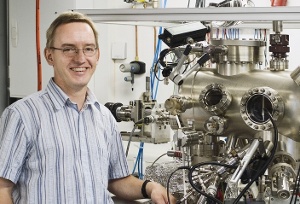About us
The Max Planck Fellow group under the guidance of Prof. Dr. Wolf Widdra started in July 2010 in the field of experimental surface science. The group focuses on the electronic structure of oxide surfaces and nanostructures as well as oxide thin films. Special focus will be on systems for which electronic correlations are important and which are beyond the traditional description in an one-electron picture. The long-term goal within the new activities will be the investigation of such systems by laser-based double photoemission spectroscopy in combination with complementary techniques as time-resolved two-photon photoemission (2PPE), scanning tunneling spectroscopy (STS), angle-resolved photoemission (ARPES), and electron energy loss spectroscopy (EELS) to advance the understanding of the peculiar electronic properties of correlated systems.
One objective of the group concerns the development of a new high-repetition pulsed light source for double photoemission coincidence experiments. It will be based on higher-harmonics generation from femtosecond lasers operating at high repetition rates. This will enable coincidence experiments which are planned in close cooperation with the Experimental Department I. A second part of the research is dedicated to the spectroscopy and the understanding of the electronic structure of transition metal oxide surfaces and epitaxial thin films. Here the interest starts at model systems like NiO(100) but extends also to more complex, but structurally still well-prepared oxide thin film systems. The combination of ARPES and 2PPE allows a broad spectroscopic characterization of occupied as well as unoccupied electronic states and their dynamic screening. The combination with STS provides an alternative spectroscopy which links directly local electronic and atomic structure. These activities are closely linked to the Collaborative Research Center 762: Functional oxide interfaces.

 Prof. Wolf Widdra
Prof. Wolf Widdra
